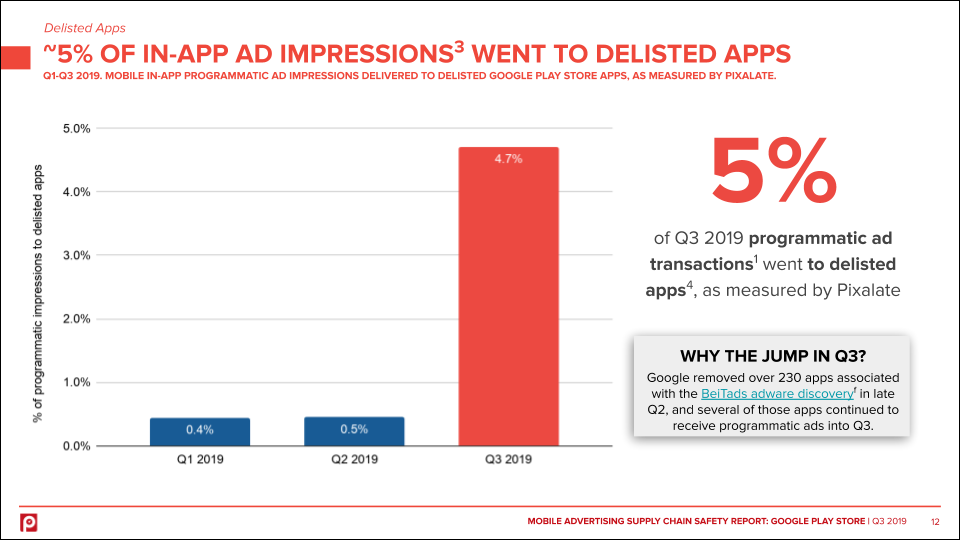
Roughly 881,000 apps were delisted from the Google Play Store from Q1-Q3 2019 — and these apps, combined, had over 18 billion global downloads, per Google's data.
With so many apps delisted — and many of them popular — advertisers are tasked with keeping their lists up to date to ensure they are not advertising on apps that have been removed from Google's store for potentially nefarious reasons.
However, as Pixalate's 2019 Mobile Advertising Supply Chain Safety Report reveals, about 5% of programmatic mobile in-app advertisements to Android devices were served to delisted apps in Q3 2019.
According to Pixalate's research, about 0.5% of programatic mobile in-app advertisements went to delisted apps in Q1 and Q2 2019, but that number jumped dramatically to 4.7% in Q3 2019.
Google removed over 230 apps associated with the BeiTads adware discovery in late Q2 2019, and several of those apps were popular and continued to receive programatic ads into Q3 2019.
Visit our page to see the 100 most popular apps delisted from the Google Play Store through Q3 2019, based on global download volume.
Download a free copy of the 2019 Mobile Advertising Supply Chain Safety Report to learn more.
Disclaimer
The content of this blog reflects Pixalate's opinions with respect to the factors that Pixalate believes can be useful to the digital media industry. Any proprietary data shared is grounded in Pixalate's proprietary technology and analytics, which Pixalate is continuously evaluating and updating. Any references to outside sources should not be construed as endorsements. Pixalate's opinions are just that, opinions, which means that they are neither facts nor guarantees.
"Delisted apps" include apps delisted on or after January 1, 2019 and not on the Google Play Store as of September 30, 2019. Delisted apps cannot reflect the initiator of the delisting action, i.e. Google or the app developer.
*By entering your email address and clicking Subscribe, you are agreeing to our Terms of Use and Privacy Policy.
These Stories on Mobile
*By entering your email address and clicking Subscribe, you are agreeing to our Terms of Use and Privacy Policy.

Disclaimer: The content of this page reflects Pixalate’s opinions with respect to the factors that Pixalate believes can be useful to the digital media industry. Any proprietary data shared is grounded in Pixalate’s proprietary technology and analytics, which Pixalate is continuously evaluating and updating. Any references to outside sources should not be construed as endorsements. Pixalate’s opinions are just that - opinion, not facts or guarantees.
Per the MRC, “'Fraud' is not intended to represent fraud as defined in various laws, statutes and ordinances or as conventionally used in U.S. Court or other legal proceedings, but rather a custom definition strictly for advertising measurement purposes. Also per the MRC, “‘Invalid Traffic’ is defined generally as traffic that does not meet certain ad serving quality or completeness criteria, or otherwise does not represent legitimate ad traffic that should be included in measurement counts. Among the reasons why ad traffic may be deemed invalid is it is a result of non-human traffic (spiders, bots, etc.), or activity designed to produce fraudulent traffic.”

